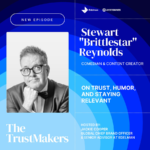By R. Larsson, Advertising Week
The latest IPA Bellwether Report offers a cautiously optimistic snapshot of the marketing landscape, with total budgets expanding at their fastest pace in a year. But while the headline figures may hint at recovery, industry leaders are quick to highlight the complexities behind the numbers. Beneath the surface, concerns persist around short-termism, talent retention, underinvestment in brand building and research, and the growing – but still misunderstood — impact of AI on marketing effectiveness.
From creative and strategy to experiential and digital, here’s how key voices from across the industry are interpreting the latest findings, and what they believe marketers must prioritise to navigate the road ahead.
Flora Joll, Strategy Director, JOAN London
An increase in marketing budgets is, of course, good news for the creative industries: it means the opportunity for a greater variety of work and potential for growth, generally. Happy days in terms of agencies’ bottom lines and hopefully retaining talent (which has been leaving both agency and client side in significant numbers), as well as making the work we’re all turning up to try and get made.
One potential fly in the ointment: there has been decreased spending on market research, which, as a strategist, doesn’t bode particularly well in terms of keeping in touch with our audiences. There is the possibility that AI is making significant inroads here already. If this is the case, marketers need to be totally clear on what they want to use AI for when it comes to creative output. This will be particularly key when it comes to bolstering low consumer confidence, which, as the report points out, is also an increasing problem.
Fergus McCallum, CEO, TBWA\MCR
In headline terms the latest Bellwether reports appear to paint a positive picture. However, dig a little deeper and it’s a right old bag of washing. Growth is primarily driven by short term tactical spend, whilst more sustainable brand building methods are static at best. Perhaps that’s no great surprise given the global tradewinds and an economy in the UK that can’t seem to make up its mind. With inflation figures going back up this week and the economy declining in Q2, I fear short termism is going to continue. But I guess that also presents an opportunity – because the businesses that will win in the long term, are those that hold firm and invest now in both brand building and sales driving.
Richard Exon, Founder, Joint
The latest Bellwether report faithfully reflects the exquisite challenge facing today’s business and marketing leaders. The undeniable truth that consistent, long term marketing investment leads to better results for all investors and stakeholders is well understood. But short term pressures and a relentless focus on cost amid geopolitical uncertainty can lead to an over reliance on tactical as opposed to strategic actions. They say to lead is to decide, and businesses that get the balance right in the next half year will enter 2026 stronger.
Patrick Reid, CEO, Imagination
The latest Bellwether report shows welcome growth in marketing budgets, but also a familiar pattern. Brands are prioritising short-term gains, with spend leaning heavily into performance channels like direct marketing and sales promotions.
Experiential marketing remains in growth, but the pace has eased. The intent is there – brands still recognise the power of real-world engagement – but they’re being more measured in how they invest.
That’s understandable in a cautious market, but it’s a risk. Experiences don’t just drive emotional connection – they deliver commercial impact, brand loyalty, and long-term equity.
The smartest brands aren’t just chasing clicks; they’re building presence, momentum, and memory. Experience is where short-term action meets long-term brand value. It’s not a nice-to-have -it’s how great brands grow.
Monica Conway – Global COO of Fuse
The latest IPA Bellwether Report offers some much-needed optimism, with total marketing budgets expanding at their fastest rate in a year. In today’s challenging financial environment, any increase in marketing budgets is a positive indicator. From a sports and entertainment standpoint, it’s especially encouraging to see event investment grow by 3.9% in Q2. This reflects a recognition among brands of the long-term value of in-person engagement. However, it’s worth noting that this is the lowest growth rate in the past 14 quarters and falls short of expectations for the current financial year.
Live events remain one of the most powerful and memorable forms of marketing. With a packed calendar of major sporting and cultural moments ahead, brands would do well to shift some of their focus from immediate returns to the long-term brand equity and consumer loyalty that events can uniquely deliver.
Charlotte Cook Anderson VP Strategic Accounts UK, Teads
The latest IPA Bellwether findings offer a slightly more optimistic look at the industry than three months ago, with overall marketing budgets up from the previous quarter. Alongside this welcome news, it also confirms what many of us already knew: marketers are still stretched and need to find the most effective ways of reaching audiences with limited budgets.
One opportunity for this, that the report identified, is engaging customers on digital channels. The report cites anecdotal evidence of companies increasing investment in digital channels as a means of achieving direct targeting. To really engage audiences in this way, brands should also consider CTV, which would allow them to reach consumers directly, in their homes, in personalised and targeted ways.
Furthermore, while AI has had a well-documented impact on the industry, as shown in the report, what’s flown under the radar for many is the impact of AI summaries on web traffic. Over the last few months, new AI summary features have been introduced to search engines, creating a considerable impact for brands with reports of reduced click-through rates on content. AI poses both an opportunity and a threat if the right measures aren’t deployed. It’s clear that for advertisers, the right balance still needs to be found, and it’s likely the next few months will prove to be crucial.











